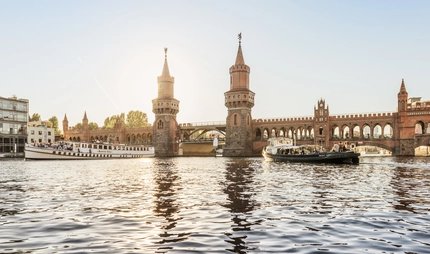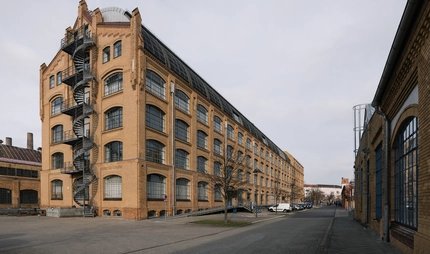
apartment tower at the 'Weberwiese'
Prototype of the new construction method
The apartment tower at Weberwiese is more than just a residential building: it is the dream of triumphant GDR socialism made manifest.
When the construction workers and tradesmen took up their tools at Marchlewskistraße 25 on the 1st of September 1951, the majority of Berlin still lay in ruins. The city and all of Germany were partitioned and the Cold War between East and West had begun.
Marchlewskistraße 25 at Weberwiese was a prominent construction site. In the East Berlin district of Friedrichshain, the newly-founded GDR was beginning its “national rebuilding programme”. It didn’t just want to build apartments: it wanted to prove that it had more to offer its population than the capitalist West.
Spacious three-room apartments were being built, complete with built-in kitchen, electric oven and central heating. Telephones and intercom systems were also provided, and even a communal antenna for television reception was supplied. The equipment was ahead of its time, as there were not yet any TV programmes, not to mention any affordable TV sets. Every tenant had access to a rooftop terrace with a glassed-in area.
The tower block was designed to make an impression from the outside as well. Tiles made from Meissen porcelain – although not from the MEISSENER porcelain factory, as was claimed for many years – cover the building, which the workers constructed in the traditional way from bricks. The corners of the building project upwards like towers. Friezes, cornices and pillars decorate the structure.
A turning point in architecture
The lead architect actually had something else in mind. Hermann Henselmann, director of the Weimar University of Architecture and Fine Arts since 1946, had designed Modernist apartment buildings before the Nazis came to power. His first sketches for the Hochhaus an der Weberwiese in 1951 were still clean-cut and functional, but the style was no longer in fashion.
Soviet functionaries criticised the work of East German architects: the new buildings appeared decadent and upper class to them. Instead, they ought to orientate themselves toward national traditions. Modern developments in architecture had already been suppressed in the Soviet Union before the Second World War. Buildings became pompous and prestigious, and Socialist Classicism prevailed.
Criticism and self-criticism
The GDR looked towards its role model, the Soviet Union. Head of state Walter Ulbricht declared that he didn’t want to see “any more American boxes or Hitleresque barracks” in Berlin. In an article, Rudolf Herrnstadt, chief editor of Neues Deutschland, denounced Henselmann’s designs for the Hochhaus an der Weberwiese as flawed.
The architect quickly found a solution: he engaged in public self-criticism after his associates and the playwright Bertolt Brecht advised him to do so. Brecht, Henselmann later explains, told him that “building for millions of people must start from the aesthetic [...] ideas of those millions of common people, and not from me trying to teach them culture”.
Henselmann took governmental guidelines and the architectural style of Karl Friedrich Schinkel as his inspiration. His new plans met with approval. And it also paid off for him personally: as the chief architect of East Berlin’s municipal administration, Henselmann designed Stalinallee, the name given to today’s Karl-Marx-Allee from 1949 until 1961. His Hochhaus an der Weberwiese became the benchmark for the new grand boulevard.

No prototype for mass housing estates
The tower block was to be finished as quickly as possible. Construction work continued through the winter, with builders working around the clock every day, under floodlights at night. The first tenants moved in on the first of May – Labour Day – 1952.
The flagship project was complete – and the SED left nothing to chance. In addition to radio reports on the new building, the GDR celebrated the Hochhaus an der Weberwiese with a commemorative stamp and its very own song.
“In Berlin, in Berlin on the Spree
a stone giant grows on Stalinallee, a stone giant grows on Stalinallee
It is no castle in the air, it can’t be
And yet it grows high into the sky.”
At the topping out ceremony, the media-savvy later head of state Erich Honecker laid the last stone. The Hochhaus an der Weberwiese made it clear: everyone was to enjoy their share of prosperity. Of the 33 new apartments, 30 were allocated to workers’ families; the family of a police officer, a teacher and an architect moved into the remaining ones. From now on they all lived in comparative luxury, paying the very low rent of 90 pfennig per square meter.
On closer inspection, the project exhibited a decisive flaw: the construction of each apartment in the tower block cost nine times more than an average apartment. Much too expensive to serve as a model for the construction of housing estates. Later, a few years after Stalin’s death, GDR architecture also looked towards international Modernism and industrial production.
Ventilation for the right indoor temperature
Many residents ended up spending their whole lives living in the Hochhaus an der Weberwiese. But not everything worked perfectly. In the early years, the lift was often stuck and the central heating could only be regulated by opening the windows. “We also heated the Weberwiese park”, one tenant recalls.
After reunification, the building was restored in the 1990s, except for the rooftop terrace. Its historic preservation order does not permit a conversion in accordance with the new safety regulations. To this day, residents are no longer allowed to use it.
Our tips for the Hochhaus an der Weberwiese
Take your time, and discover Karl-Marx-Allee on foot or by bike. Info boards provide assistance and insights along the way. Those who would like to find out more about this major avenue can book a tour: City tours from art:Berlin, Ansichtssachen and TICKET B guide you along exciting paths through the history of Berlin’s buildings.
Practical information from visitBerlin
The best way of reaching Karl-Marx-Allee from Alexanderplatz is by taking the U5 U-Bahn line to Weberwiese station. To explore the city, we recommend the Berlin Welcome Card for public transport.



